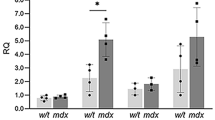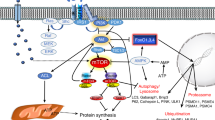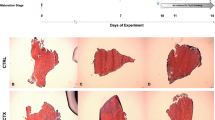Abstract
MUSCLE proteins undergo continuous intracellular turnover as do proteins in other cells1,2. Furthermore, hormones, nutrients and work load can alter rates of protein synthesis and degradation in muscle, resulting in growth or atrophy of these tissues1,2. In hereditary muscular dystrophies, where there is prominent wasting of the affected tissues, rates of both total protein synthesis and degradation are elevated3–10. The immediate cause of this muscle atrophy is the imbalance resulting from an increase in protein degradation which exceeds a smaller enhancement in average protein synthesis. No simple explanation based on a defect in the response of dystrophic cells to known hormonal or nutritional factors has satisfactorily explained the elevation in the rates of both protein synthesis and degradation. We have now investigated the possible role of increased cellular Ca2+ as a mediator of such changes in protein metabolism based on other known structural and biochemical alterations in dystrophic muscles11,12. Lesion(s) involving membranes in muscle as well as other cells occur in hereditary dystrophies, including the main human form, Duchenne dystrophy11,12. One characteristic of the dystrophic plasma membrane seems to be an increased permeability to the high concentrations of Ca2+ normally present in extracellular fluid11,12. In addition, studies have suggested a decreased ability of sarcoplasmic reticulum to sequester Ca2+ in dystrophic muscles13,14. Thus, it is possible that increased Ca2+ might be responsible for the stimulation of both protein synthesis and degradation which occurs in these muscles. To test this idea, we have experimentally increased the uptake of external Ca2+ into rat muscles by using the divalent cation ionophore, A23187. The ability of this ionophore to increase the transport of Ca2+ across membranes has resulted in its application as a widely used tool for the study of many Ca2+-dependent cellular processes15. The experiments reported here demonstrate that increased movement of Ca2+ into muscle can produce effects which closely resemble dystrophic muscle and that the increased net catabolism can be reversed by certain factors.
This is a preview of subscription content, access via your institution
Access options
Subscribe to this journal
Receive 51 print issues and online access
$199.00 per year
only $3.90 per issue
Buy this article
- Purchase on SpringerLink
- Instant access to full article PDF
Prices may be subject to local taxes which are calculated during checkout
Similar content being viewed by others
References
Goldberg, A. L. & St John, A. C. A. Rev. Biochem. 45, 747–803 (1976).
Goldberg, A. L., Etlinger, J. D., Goldspink, D. F. & Jablecki, C. Med. Sci. Sports 7, 248–261 (1975).
Simon, E. J., Gross, C. S. & Lessell, I. M. Archs Biochem. Biophys. 96, 41–46 (1962).
Weinstock, I. M., Soh, T. S., Freedman, H. A. & Cutler, M. E. Biochem. Med. 2, 345–356 (1969).
Strivastava, U. Can. J. Biochem. 46, 35–41 (1968).
Rourke, A. W. J. cell. Physiol. 86, 343–352 (1975).
Goldberg, A. L., Griffin, G. E. & Dice, J. F. in Pathogenesis of Human Muscular Dystrophies (ed. Rowland, L. P.) 376–385 (Excerpta Medica, Amsterdam, 1977).
Battelle, B. & Florini, J. R. Biochemistry 12, 635–643 (1973).
Kruh, J., Dreyfus, J., Schapira, G. & Gey, G. O. J. clin. Invest. 39, 1180–1188 (1960).
Ionascescu, V., Zellweger, H. & Conway, T. W. Archs Biochem. Biophys. 144, 51–58 (1971).
Engel, W. K. in Pathogenesis of Human Muscular Dystrophies (ed. Rowland, L. P.) 277–309 (Excerpta Medica, Amsterdam, 1977).
Engel, A. G., Mokri, B., Jerusalem, F., Sakakibara, H. & Paulson, O. B. in Pathogenesis of Human Muscular Dystrophies (ed. Rowland, L. P.) 310–324 (Excerpta Medica, Amsterdam, 1977).
Takagi, A., Schotland, D. L. & Rowland, L. P. Archs Neurol. 28, 380–388 (1973).
Samaha, F. J. in Pathogenesis of Human Muscular Dystrophies (ed. Rowland, L. P.) 633–639 (Excerpta Medica, Amsterdam, 1977).
Rasmussen, H. & Goodman, D. Physiol. Rev. 57, 421–510 (1977).
Fulks, R. M., Li, J. B. & Goldberg, A. L. J. biol. Chem. 250, 290–298 (1975).
Li, J. B. & Goldberg, A. L. Am. J. Physiol. 231, 441–448 (1976).
McKee, E. E., Cheung, J. Y., Rannels, D. E. & Morgan, H. E. J. biol. Chem. 253, 1030–1040 (1978).
Stracher, A., McGowan, E. B. & Shafiq, S. A. Science 250, 50–53 (1978); McGowan, E. B., Shafiq, S. A. & Stracher, A. Expl Neurol. 50, 649–657 (1976).
Libby, P. & Goldberg, A. L. Science 199, 534–536 (1978).
Van der Westhuyzen, D. R., Matsumoto, K. & Etlinger, J. D. J. Cell Biol. 79, 325a (1978).
Buresora, M., Gutmann, E. & Klicpera, M. Experientia 25, 144–145 (1969).
Kendrick-Jones, J. & Perry, S. V. Nature 213, 406–408 (1967).
Goldspink, D. F. Biochem. J. 174, 595–602 (1978).
Goldberg, A. L., Jablecki, M. & Li, J. B., Ann. N.Y. Acad. Sci. 228, 190–201 (1974).
Brevet, A., Pinto, E., Peacock, J. & Stockdale, F. E. Science 193, 1152–1154 (1976).
Walker, G. & Strohman, R. Expl Cell Res. 116, 341–349 (1978).
Grinstein, S. & Erlij, D. J. Membrane Biol. 29, 313–328 (1976).
Ridgway, E. B. & Gordon, A. M. Science 189, 881–884 (1975).
Etlinger, J. D. & Goldberg, A. L. Proc. natn. Acad. Sci. U.S.A. 74, 54–58 (1977).
Reddy, M. K., Etlinger, J. D., Rabinowitz, M., Fischman, D. A. & Zak, R. J. biol. Chem. 250, 4278–4284 (1975).
Dayton, W. R., Reville, W. J., Goll, D. E. & Stromer, M. H. Biochemistry 15, 2159–2167 (1976).
Kar, N. C. & Pearson, C. M. Muscle Nerve 1, 308–313 (1978).
Statham, H. E., Duncan, C. J. & Smith, J. L. Cell Tissue Res. 173, 193–209 (1976).
Author information
Authors and Affiliations
Rights and permissions
About this article
Cite this article
KAMEYAMA, T., ETLINGER, J. Calcium-dependent regulation of protein synthesis and degradation in muscle. Nature 279, 344–346 (1979). https://doi.org/10.1038/279344a0
Received:
Accepted:
Issue date:
DOI: https://doi.org/10.1038/279344a0
This article is cited by
-
Ultrastructural study of the effect of calcium ionophore, A23187, on rat muscle
Acta Neuropathologica (1986)
-
Ca overload and the action of calcium sensitive proteases, phospholipases and prostaglandin E2 in myocardial cell degradation
Basic Research in Cardiology (1985)
-
Purification and partial characterization of two forms of Ca2+-activated neutral protease from calf brain synaptosomes and spinal cord
Neurochemical Research (1984)
-
Adaptive response of mammalian skeletal muscle to exercise with high loads
European Journal of Applied Physiology and Occupational Physiology (1984)



